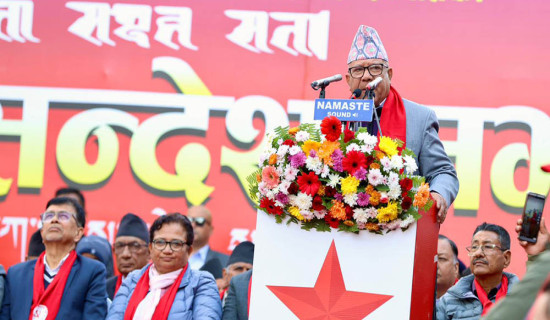- Saturday, 20 December 2025
Paddy production up by 7%
By Laxman Kafle,Kathmandu, Dec. 30: Paddy production has increased significantly in the country this year, mainly due to favourable monsoon and increase in the use of advanced and hybrid varieties of seeds. According to the report published by the Ministry of Agriculture and Livestock Development (MoALD) on Thursday, paddy production has increased by 6.94 per cent to 5.486 million tonnes in the fiscal year 2022/23 compared to last year’s production.
A total of 5.13 million tonnes of paddy was produced in the last fiscal year 2021/22. In the fiscal year, 2020/21, Nepal had grown 5.621 million tonnes of rice, the highest yield.“Timely and average favourable monsoon, though delayed, availability of chemical fertilisers in Terai district, increase in the use of advanced and hybrid varieties of seeds and
some increase in the access to agricultural technology at local levels contributed to increased paddy production this year,” said Prakash Kumar Sanjel, spokesperson of the Ministry of Agriculture and Livestock Development.
The productivity of paddy has increased by 9.12 per cent to 3.79 tonnes per hectare this year.However, the area of paddy plantation had decreased by 2 per cent this fiscal year as compared to last fiscal year.The paddy plantation had been done at around 1.447 million hectares of land which was 29,589 hectares less than the last fiscal year, the report said.
According to the preliminary projection, it is seen that there has been an increase in paddy production by 33.33 per cent in Sudurpashchim Province compared to the previous fiscal year. Last year, due to unseasonal rains and damage to paddy crops in Kailali and Kanchanpur of Sudurpachchim Province, the production had been reduced significantly.
Apart from Sudurpashchim Province, production has increased by 15.2 per cent in Lumbini Province this year compared to last year, 5.72 per cent in Province 1, 3.46 per cent in Karnali and 0.18 per cent in Madhes Province.
However, paddy production has decreased by 1.45 per cent in Bagmati and 3.74 per cent in Gandaki Province this year as compared to last year. Madhes Province has occupied first position to grow paddy where 1.388 million tonnes paddy was produced.
A total of 1,336,057 tonnes of paddy was produced in Province 1, 500,446 tonnes in Bagmati Province, 391,121 tonnes in Gandaki, 1,151,313 tonnes in Lumbini, 129,473 tonnes in Karnali and 589,221 tonnes in Sudurpashchim Province this year.
The paddy production yield is highest in Province 1 followed by Bagmati. The production yield stood at 4.02 tonnes per hectare in Province 1 and 3.84 tonnes per hectare in Bagmati Province.Production yield stood at 3.81 tonnes per hectare in Lumbini Province, 3.70 tonnes per hectare in Madhes, 3.68 tonens per hectare in Gandaki Province, 3.63 tonnes per hectare in Sudurpaschim Province and 3.35 tonnes per hectare in Karnali Province.
About 480,000 tonnes of rice in shortfall The increase in the production of paddy would support achieving the higher rate of economic growth as the contribution of paddy to the Gross Domestic Products stood at 4 per cent.
The contribution of paddy to the AGDP stands at 13 per cent at present. Joint Secretary Sanjel expressed his hope that the import of rice would decrease in the days to come due to increase in the production of paddy and productivity.
“We have to promote the use of advanced and hybrid seeds and technologies to increase productivity as there is a slim chance to expand the area of cultivation,” he said. It is a must to promote cultivation of spring rice (chaite paddy) to meet the shortfall as the production of spring paddy is about 20 per cent more than seasonal paddy.
According to the requirement of food grains (rice, maize, wheat, millet, buckwheat), it is about 181 kg per person per year, and on this basis, rice consumption is about 121 kg per person per year. But in Nepal, the average consumption per person per year is about 137 kg.
The requirement of rice is around 4 million tonnes . In terms of production, assuming 64 per cent milling percentage in about 5.5 million paddy, about 3.52 million tonnes of rice will be available. According to this calculation, there is a shortage of about 480,000 tonnes of rice in Nepal.

















